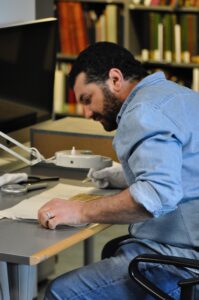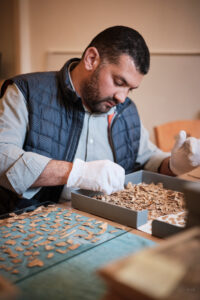This series of interviews shines a spotlight on researchers working on or with the Caliphal Finances project. Each interview showcases the variety of scholarship connected to our research. This week, we feature Arabic papyrologist Prof. Dr. Khaled Younes of the University of Sadat City and the French Institute for Oriental Archaeology (IFAO) in Cairo. We were very happy to have Khaled here in Edinburgh as one of the participants in our workshop Abbasid-Era Fiscal Documents. In this interview, he shares his current projects working with Arabic papyri as well as insights in fiscal history from the point of view of documentary papyri.
Could you briefly tell us about your current role as well as your background?
I am a Professor of Islamic History and Civilization at the University of Sadat City in Egypt and a Scientific Collaborator at the French Institute for Oriental Archaeology (IFAO) in Cairo. I earned my Bachelor’s degree with distinction in Tourism Guidance from Menoufia University in 2003, followed by a Master’s degree from Suez Canal University in 2008.
In March 2009, I began my doctoral research at Leiden University as part of the ERC project “The Formation of Islam: the View from Below,” under the supervision of Professor Petra M. Sijpesteijn (Leiden University) and Professor Geoffrey Khan (University of Cambridge). I successfully defended my PhD dissertation, “Joy and Sorrow in Early Muslim Egypt: Arabic Papyrus Letters – Text and Content,” in 2013 and subsequently returned to Egypt to resume my permanent teaching position at the University of Sadat City.
From January 2017 to March 2019, I served as a research associate at the IFAO. Between December 2018 and July 2021, I served as a scientific researcher at the Papyrus Collection of the Austrian National Library in Vienna, as part of the project “Papyri of the Early Arab Period Online” funded by the Andrew W. Mellon Foundation.

Photo provided by Khaled Younes.
Can you summarise your main research areas and current projects?
My research primarily draws on Arabic documentary papyri from early Islamic Egypt, complemented by contemporary literary sources in Arabic. These sources offer a unique and multifaceted view of administrative practices, social relations, and daily life during the formative period of Islamic rule in Egypt.
I am currently engaged in several research projects, including:
- The publication of the Arabic Papyri from Fustat: In collaboration with Dr. Sobhi Bouderbala of Tunis University, I am working on the edition and study of Arabic papyri from Fustat. This project aims to publish a comprehensive volume, focusing on the social, administrative, and economic aspects of early Islamic Egypt as revealed through documentary sources.
- Cataloging of the Arabic Papyri at the IFAO: I am currently involved in the cataloging of the Arabic papyri held at the IFAO in Cairo, with the aim of enhancing accessibility to these materials for researchers and contributing to future editions and studies.
How do fiscal theories, practices, and institutions feature in your work? How are you approaching these topics?
Fiscal practices and institutions are central to my study of early Islamic Egypt, particularly in understanding how the emerging Islamic state established and maintained control over resources, populations, and administrative structures. I approach these issues primarily through documentary papyri, which provide direct evidence of tax collection, land management, financial obligations, and bureaucratic correspondence. For instance, papyrological sources provide valuable insights into the administration of caliphal estates and mustaghallāt (revenue-generating properties such as houses (dūr), shops (ḥawānīt), and other assets), especially those associated with al-sayyida (the Lady), a title typically referring to the caliph’s mother. These documents shed light on the operational responsibilities of the agents appointed to manage such estates and the Lady’s influence in provincial governance, rooted in her prominent status and considerable wealth.

Photo provided by Khaled Younes.
In your opinion, what is a key argument or prevailing assumption in Islamic fiscal history that needs to be challenged?
A particularly pressing challenge, in my view, is to reassess the relationship and division of authority between the head of the treasury (ṣāḥib al-kharāj) and the governor, only appointed ʿalā al-ṣalāh. The commonly assumed separation between fiscal and administrative-military functions requires deeper investigation, especially in light of documentary evidence suggesting overlapping jurisdictions and more fluid administrative realities on the ground. Understanding how these responsibilities were distributed between the two offices is essential to grasp how fiscal, political and administrative developments were influenced by individual actors and shifting local and empire-wide developments.
A big thank you to Khaled Younes for sharing his thoughts with us this week! To read more of these interviews with friends of the Caliphal Finances project, click here.
Banner image: a tiny piece of rolled-up papyrus. Photo provided by Khaled Younes.




Leave a Reply